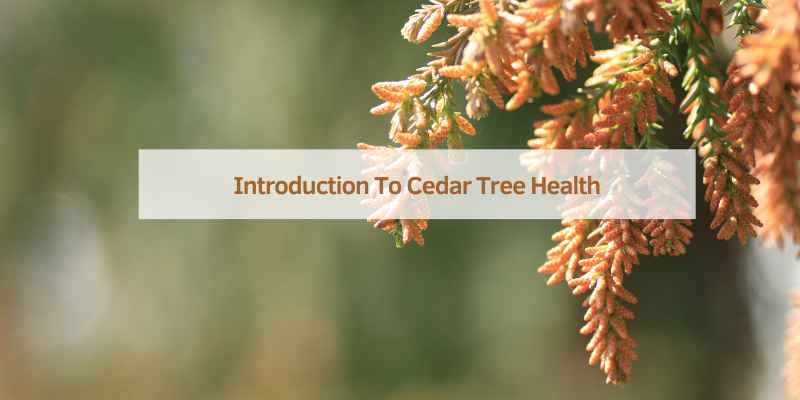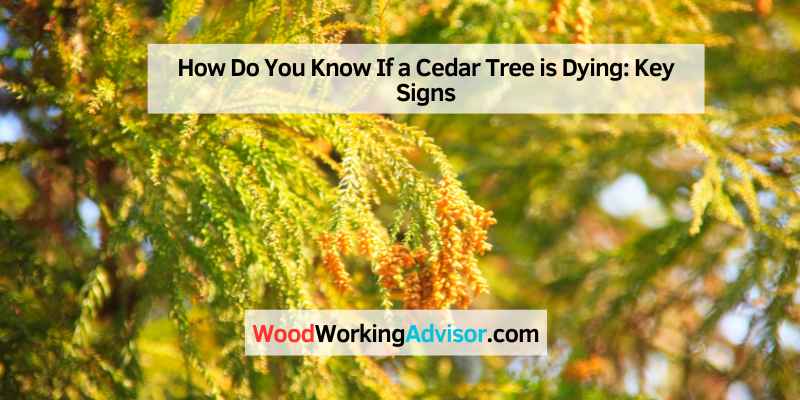A dying cedar tree shows brown, dry, and brittle leaves. It may also have a thinning canopy and dead branches.
Cedar trees are a popular choice for landscaping due to their beauty and durability. Recognizing the signs of a dying cedar tree early can help in taking timely action to save it. Common indicators include discolored foliage, which turns brown and dry, and a thinning canopy.
Dead or brittle branches also signal distress. By monitoring these signs, you can maintain the health and longevity of your cedar trees. Understanding these symptoms is crucial for effective tree care and ensuring your landscape remains lush and vibrant. Proper attention and timely intervention can often revive a struggling cedar tree.
Introduction To Cedar Tree Health
Cedar trees are important to ecosystems. They provide shade and shelter. They are also home to many animals. Cedar trees have many uses. People use their wood for furniture and buildings.
Early detection of a dying cedar tree is crucial. It can save the tree. It can also prevent the spread of disease. A sick tree can harm other plants. Identifying problems early helps maintain a healthy garden.

Physical Symptoms Of Decline
Cedar trees should have green leaves. Yellow or brown leaves are signs of trouble. These colors mean the tree is not healthy. Green leaves turning brown is not good. The tree might need help soon.
Healthy cedar trees have smooth bark. Cracks in the bark are bad signs. Peeling bark is also a problem. Holes in the bark can mean pests. Bark falling off shows severe issues. The tree could be dying if these signs appear.
Foliage Changes To Look For
Needle browning or yellowing is a clear sign. Healthy cedar trees have green needles. If the needles turn brown or yellow, it means trouble. This change often starts at the tips. It can spread quickly to other parts.
Premature needle drop is another warning. Cedars usually shed old needles in fall. If needles fall off in other seasons, be alert. This can mean stress or disease. Watch for large clumps of fallen needles.
Bark And Trunk Indicators
Cracks and splits in the bark can signal trouble. Healthy cedar trees have smooth, intact bark. Large cracks may expose the tree to pests and diseases. These splits can weaken the tree. It becomes more prone to breaking during storms. Pay attention to the size and frequency of cracks. Multiple cracks are a bad sign. They often start small and get bigger over time. Deep cracks are especially concerning. Regularly inspect your cedar tree for these signs.
Fungal growths often indicate a dying cedar tree. Mushrooms or other fungi at the base are a red flag. Healthy trees usually do not have these growths. Fungi feed on decaying wood. This means the tree is likely rotting inside. Check for spongy or soft spots on the trunk. These areas are usually infected. Fungal growths can spread quickly. Early detection is key to saving your tree. Remove affected parts if possible. Use fungicides as a preventive measure.
Root Health And Stability
Soil disruption can harm cedar trees. Roots need stable soil to grow strong. Exposed roots may dry out and die. This can make the tree weak. Watch for changes in soil around the tree. Heavy rain or digging can expose roots. Protect the roots by covering them with soil.
Root rot is a serious problem. It happens in wet soil. Mushy roots are a sign of rot. Leaves may turn yellow and fall off. The tree can become unstable. Check the roots for soft spots. Healthy roots are firm and white. Remove infected roots to save the tree.
Pest Infestations In Cedar Trees
Cedar trees often attract common pests like aphids and spider mites. These pests can damage the tree’s health. Aphids leave a sticky residue on the leaves. Spider mites create tiny webs on the tree branches. Both pests suck the sap from the tree, weakening it over time. Scale insects are another common pest. They appear as small bumps on the branches. Scale insects also suck the sap, causing further damage. Early detection of these pests is crucial for the tree’s health.
Yellowing leaves are a sign of pest damage. Leaves may also become curled or distorted. Look for holes in the bark. This indicates boring insects. Sticky residue on leaves or branches suggests aphids. Webbing on branches points to spider mites. Falling needles can indicate a serious infestation. Dead branches are a late sign of damage. Regular checks help to catch these signs early.
Disease And Pathogen Identification
Cedar trees can be affected by various diseases. Fungal infections are common, leading to rot and mold. Bacterial diseases can also harm cedar trees. Viruses are less common but still possible. Insects can spread these diseases. Proper care can help prevent infections.
Yellowing leaves are a sign of disease. Falling needles indicate a problem. Bark discoloration can occur. Sappy excretions suggest an infection. Visible fungus or mold is a clear sign. Stunted growth shows the tree is unwell. Dead branches point to serious issues. Early detection can save the tree.
Environmental Stress Factors
Drought can cause cedar trees to weaken. Leaves may turn brown or yellow. This is a sign of water stress. Overwatering can also harm cedars. Roots may rot if the soil is too wet. Proper watering is crucial for cedar health.
Extreme cold can damage cedar trees. Frost can kill leaves and branches. Hot weather can cause dehydration. This makes the tree more vulnerable. Strong winds can break branches. Weather extremes put stress on cedar trees.
Preventive Measures And Treatment
Regular watering helps keep cedar trees healthy. Mulching around the base helps retain moisture. Pruning dead or diseased branches prevents further spread. Fertilizing in spring provides essential nutrients. Avoid mechanical injuries to the tree trunk. Ensure proper spacing between trees to reduce competition. Monitor for pests and diseases regularly.
Identify the disease affecting the cedar tree. Use appropriate fungicides for fungal infections. Apply insecticides if pests are found. Remove severely infected branches to prevent spread. Consult a tree specialist for severe cases. Follow a regular care routine to help the tree recover. Ensure the tree receives adequate water and nutrients.
When To Call A Professional
Cedar trees can show signs of illness. Brown leaves or bare branches are common signs. Weak branches may fall easily. Fungus on the tree might signal decay. Insect infestations can also be harmful. Cracks in the trunk are another warning sign. It may be time to call an arborist. An arborist can evaluate the tree’s health.
Arborists are tree experts. They can diagnose tree problems. They offer solutions to save the tree. Arborists use special tools to treat diseases. They can trim branches safely. Arborists also prevent future issues. Their involvement ensures the tree stays healthy.

Frequently Asked Questions
What Does A Cedar Tree Look Like When It’s Dying?
A dying cedar tree shows brown, dry needles, brittle branches, and sparse foliage. It may also have peeling bark and visible pest damage.
How Do You Revive A Dying Cedar Tree?
Revive a dying cedar tree by ensuring proper watering, mulching, and pruning. Check for pests and diseases. Use fertilizer appropriately.
Can Brown Cedars Come Back?
Brown cedars can recover with proper care. Water them deeply, prune dead branches, and ensure good soil drainage.
What Disease Kills Cedar Trees?
Cedar trees often die from cedar-apple rust, a fungal disease. This disease causes orange, gelatinous galls on branches. Prevention includes removing nearby apple trees. Treat infected trees with fungicide.
Conclusion
Recognizing signs of a dying cedar tree is crucial for timely intervention. Monitor for yellowing needles, sparse foliage, and brittle branches. Early detection can save your tree. Regular maintenance and professional advice ensure your cedar tree thrives. Keep an eye out for changes and act quickly to preserve its health and beauty.


